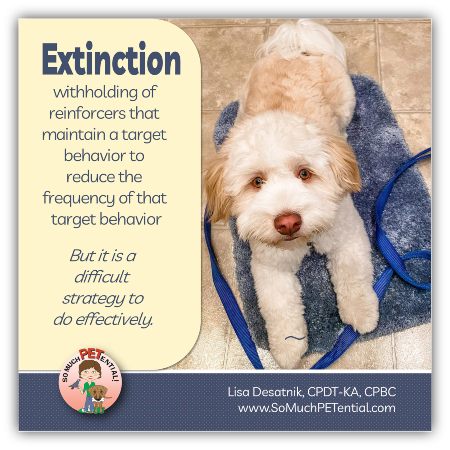Meet Cody. An almost one year old havanese who mastered the art of barking at, pawing (and scratching), and jumping on his human mom (I will refer to those behaviors as needs seeking behaviors) to get anything he wants in life. He used those behaviors frequently to get treats, attention, play interaction with his mom (or other people), or the opportunity to go outside. It was making life with him pretty intolerable. In this post, I talk about extinction in dog training and why just ignoring your dog is not the most effective way to stop unwanted behavior.
 At our first appointment, Sue was feeling beyond frustrated, even hopeless to seeing a brighter future for herself and her little companion. She was understandably tired of Cody dictating how every waking moment of every day should be centered around him. She could not cook. She could not paint – her favorite new activity. She could not talk on the phone. She could not have a visitor over. She could not relax on the couch and watch television at night. She also could not often enjoy taking him for walks. There is a lot of strength packed in Cody’s body and he used every bit of it to pull her or run to the end of the leash toward something of interest. Sue sustained some injuries from one of those incidents.
At our first appointment, Sue was feeling beyond frustrated, even hopeless to seeing a brighter future for herself and her little companion. She was understandably tired of Cody dictating how every waking moment of every day should be centered around him. She could not cook. She could not paint – her favorite new activity. She could not talk on the phone. She could not have a visitor over. She could not relax on the couch and watch television at night. She also could not often enjoy taking him for walks. There is a lot of strength packed in Cody’s body and he used every bit of it to pull her or run to the end of the leash toward something of interest. Sue sustained some injuries from one of those incidents.
In Applied Behavior Analysis, extinction is a term that refers to withholding of reinforcers that maintain a target behavior to reduce the frequency of that target behavior. As Sue came to learn, trying to reduce Cody’s needs seeking behaviors by just ignoring them until they went away was simply not working. Those unwelcome behaviors were not only continuing but strengthening over time. I saw that first hand.
Why Extinction Alone Can Be Ineffective
There are numerous reasons why extinction as a behavior change strategy are not your best choice. Extinction is a slow process which makes it difficult to carry through consistently to see success.
When you withdraw reinforcement from an animal for a behavior with a history of causing desired outcomes, you can create frustration. That often leads to an escalation in the unwanted behavior referred to as an extinction burst. During extinction burst, you will often see an increase in variability of the behavior and also more emotionally driven behaviors. In Cody’s case, the escalation may look like moving from whining to barking to pawing to jumping on to biting. At a certain point, you are not going to be able to continue ignoring the behaviors. You do something to stop them but what you are actually doing is reinforcing the escalated behaviors. Now you have taught your dog to do whatever it was that he did just before getting your attention, a toy, or an opportunity to do anything else of value to him.
There is always the chance that, while you are creating frustration, your pet’s target behavior can produce reinforcement from another source. This is called bootleg reinforcement. I wrote about it in another blog post. Let’s say for example, that while Sue was ignoring Cody’s needs seeking behaviors as she continued to cook at the kitchen counter, that some scraps fell to the ground. The timing of the delivery of those scraps served as a reinforcer for Cody’s behaviors.
With extinction, it isn’t enough for you to prevent reinforcement from the unwanted behavior some of the time. You need to prevent reinforcement from the target behavior in EVERY instance. That is a hefty task especially since it is a slow process. If you fail to do this, you will be intermittently reinforcing the behavior and that causes a gambling addiction in your pet. When he does not know which time will earn the reinforcer, he will have more incentive to keep trying.
Also with extinction, spontaneous recovery can and often does occur. This is the reappearance of the target behavior after extinction. If you can avoid giving any reinforcement for that re-occurring behavior, it will extinguish quicker; but the problem is, you may go back to reinforcing it.
What to do instead of extinction alone to change behavior
For Cody (and others), it involved a multi-layer approach.
We came up with a plan to get his enrichment and rest needs met. Among that list were training (yes, training with positive reinforcement is enrichment), working for food, teaching him independent play, resting in his crate, and day care once or twice a week.
It also involved thoughtfully arranging the environment to try and prevent practice of the unwanted behaviors in situations where needs seeking would be predicted. For those familiar with Applied Behavior Analysis, this is known as antecedent arrangement. Some examples of this include putting Cody in his crate while Sue is painting or cooking, or giving him an activity or chew toy BEFORE his needs seeking behaviors begin.
When she was in training mode, she could practice with him building value for the behaviors that she would like to see in him during those trigger situations like laying on his mat. Since she had done work on getting his needs met and teaching him more independent activities, when she withdrew reinforcement for his needs seeking behaviors, there was a greater likelihood that he would choose to do other things instead. His needs seeking behaviors would lessen.
And they have.
Last week was our last lesson together. Sue took me on a walk where I could see how beautifully Cody walked with her (he had injured her pulling her over earlier). She showed me some of his ‘tricks’. She now watches tv with him and just enjoys his company. For the most part, he can be out when she is doing activities that would have been triggers. Occasionally she will see those needs seeking behaviors reoccur but since she is ignoring them, they extinguish quicker. When I left, she told me I had given her a dog she loves to be with. It gave me a lump in my throat. These are moments that give this work purpose for me.







